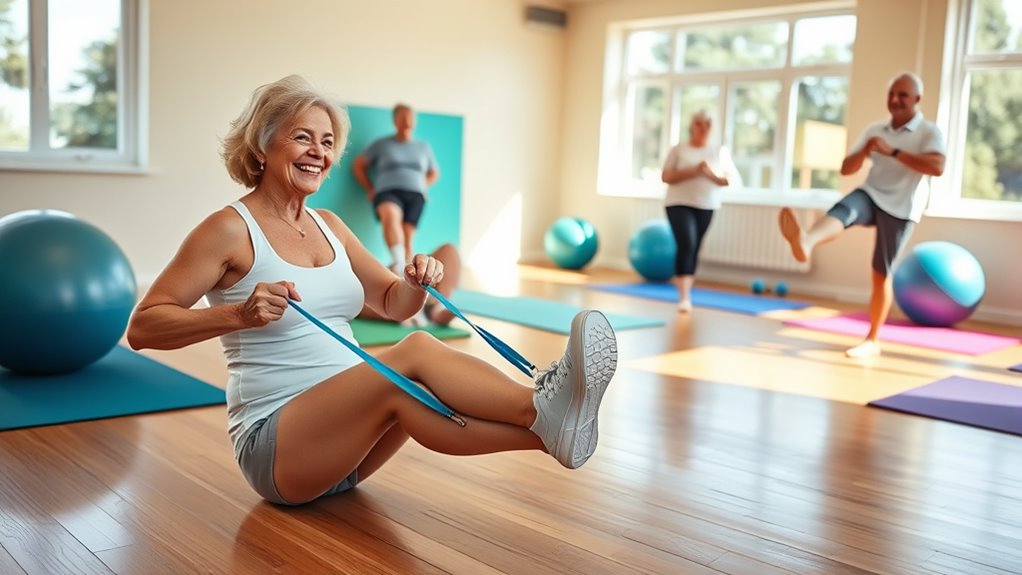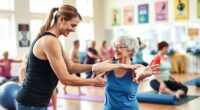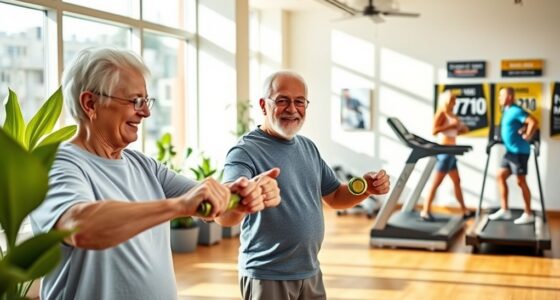Leg exercises are essential for seniors to build strength and stability, enhancing mobility and reducing fall risks. Exercises like chair squats and standing knee lifts not only improve leg strength but also boost balance. Combining these with proper safety measures—like consulting a physician and using non-slip footwear—ensures a safer workout experience. Incorporating these exercises into your daily routine can further help you maintain an active lifestyle. Keep exploring to discover more effective strategies and exercises.
Key Takeaways
- Chair squats strengthen lower body muscles, enhancing stability for daily activities and reducing fall risk.
- Calf raises improve ankle strength and stability, crucial for maintaining balance while walking.
- Seated leg lifts increase flexibility and muscle engagement, supporting overall leg strength.
- Glute bridges strengthen the core and posterior chain, contributing to better posture and mobility.
- Regularly incorporating these exercises into a routine fosters confidence and independence in seniors’ daily lives.
Importance of Leg Exercises for Seniors
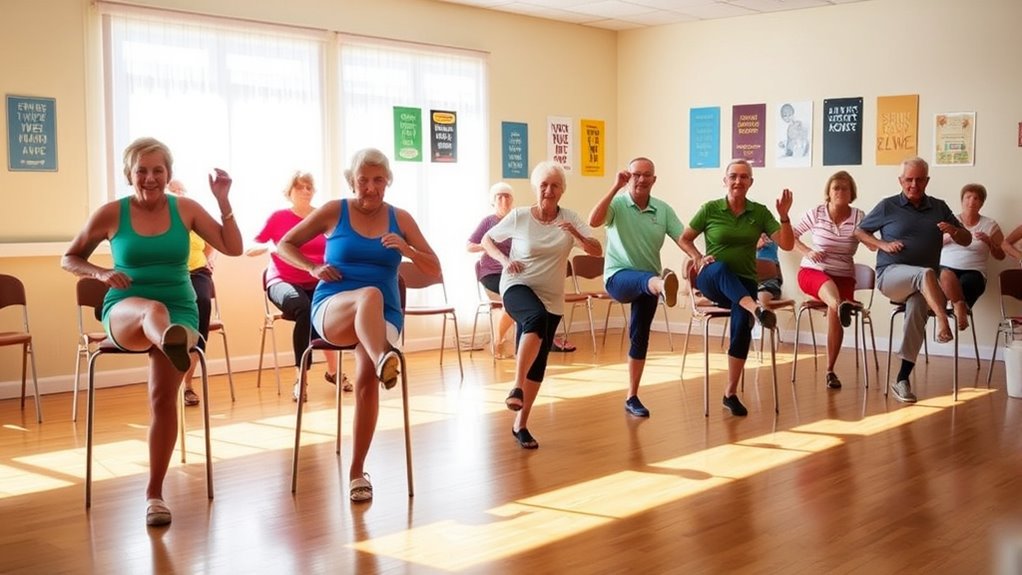
Leg strength is essential for seniors, as it directly impacts your mobility and balance. Engaging in regular leg exercises boosts your strength, making it easier to walk, climb stairs, and rise from chairs without help.
Leg strength is vital for seniors, enhancing mobility and balance for greater independence in daily activities.
This independence is critical for maintaining your quality of life and overall health. Strong legs also improve circulation and cardiovascular health, which promotes vigor among seniors. Additionally, newborns benefit from strong parental support, which can foster a healthy environment for physical activity. Research indicates that mental clarity can also be enhanced through physical activity, benefiting overall well-being. Furthermore, engaging in physical activity can potentially help reduce anxiety and depression symptoms in seniors, enhancing their emotional well-being. Practicing self-reflection on your progress can further motivate you to stick with your exercise routine.
Furthermore, leg exercises enhance flexibility, reduce stiffness, and contribute to better joint health, making movement more comfortable.
By incorporating leg-strengthening activities into your routine, you can combat the natural decline in muscle mass that comes with aging, ultimately preserving your strength and functional fitness.
Prioritizing leg exercises is key to enjoying a more active and independent lifestyle, as it helps combat the effects of neglecting self-care that can adversely affect physical health.
The Role of Leg Strength in Senior Mobility
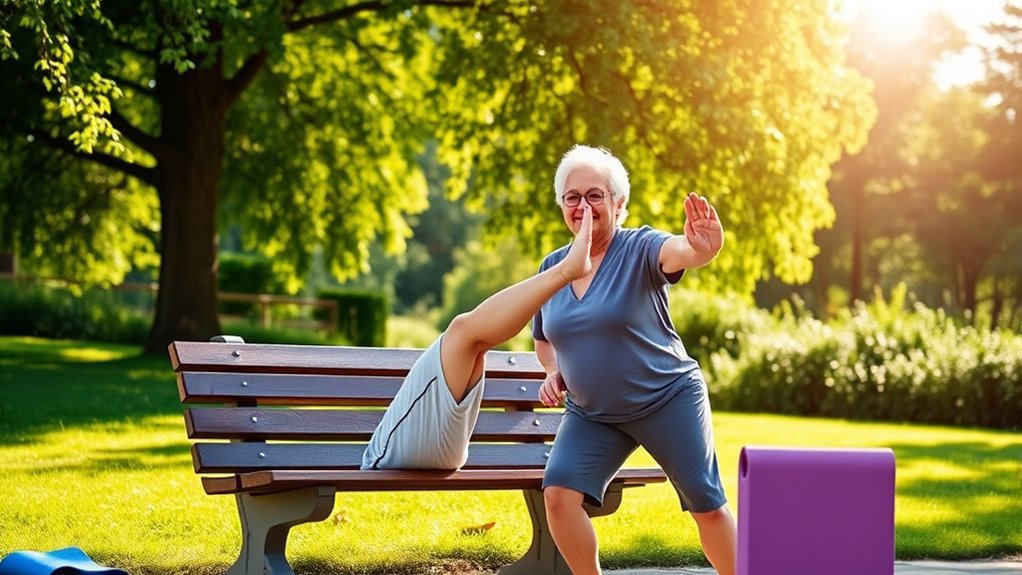
Strong legs not only help you with daily activities like walking and climbing stairs but also greatly reduce your risk of falls. Focusing on leg strength is a key strategy for enhancing your stability and confidence in everyday life. Additionally, proper nutrition plays a vital role in supporting muscle strength and overall physical health as you age, including the importance of high-protein breakfasts to fuel your body for activity. Engaging in regular preventive maintenance can also help maintain your overall physical condition, ensuring that you stay active and mobile. It’s beneficial to incorporate exercise routines that specifically target the legs to improve endurance and strength. Furthermore, maintaining good drainage in your exercise environment can help prevent slips and falls, promoting safer workouts.
Mobility Enhancement Through Strength
When you strengthen your legs, you lay the foundation for improved mobility and independence in daily activities. Engaging in leg strengthening exercises enhances muscle strength, which is essential for mobility enhancement as you age. Additionally, early socialization with diverse activities helps bolster overall confidence in physical capabilities. Regular physical activity can also play a crucial role in protecting energy levels, ensuring you remain active and engaged throughout the day. A balanced diet rich in whole foods supports muscle recovery and overall health, further enhancing your ability to perform these leg exercises.
Incorporating a variety of exercises, such as scratching posts, can also improve your overall stability and body awareness, enhancing your training effectiveness. With better lower body strength, you’ll notice improvements in balance and stability, making it easier to navigate your environment confidently. This increased strength can considerably reduce the risk of falls, a major concern for seniors. Regular leg training also supports joint health and flexibility, helping to combat stiffness often associated with aging. By prioritizing these exercises, you promote functional independence, allowing you to continue enjoying your daily routines with ease and confidence. Additionally, incorporating primitive weapons into your training can enhance your overall stability and strength in various situations.
Embrace leg workouts to maintain your mobility and enhance your quality of life.
Fall Risk Reduction Strategies
To effectively reduce fall risks, focusing on leg strength is key, since it directly influences your ability to maintain balance and perform everyday tasks.
Regular leg exercises, like squats and lunges, not only improve muscle strength but also enhance stability and coordination, essential for older adults. Incorporating community collaboration in exercise routines can further motivate seniors to stay active and engaged. Additionally, engaging in cultural intelligence can help seniors adapt to new exercise environments and foster connections with others. Maintaining a clean living space can also support safer mobility by minimizing tripping hazards and ensuring clear pathways, which relates to the importance of regular home cleaning. Engaging in strength training is crucial, as it can help counteract the natural decline in muscle mass, which is similar to the effects observed in gout nutrition management.
Strength training can counteract the natural decline in muscle mass, helping maintain independence and mobility as you age.
A 2023 review in *Frontiers in Public Health* emphasizes that these exercises contribute greatly to fall risk reduction. Additionally, engaging in regular exercise fosters curiosity-driven individuals who are more adaptable to change, further supporting overall well-being in seniors.
Daily Activity Support
Building on the importance of leg strength in reducing fall risks, it’s clear that strong legs play an essential role in your daily mobility. Engaging in the best leg strengthening exercises helps you maintain your lower body strength, which is crucial for performing daily activities like walking, climbing stairs, and getting in and out of chairs. Additionally, creating a safe and accessible home environment can further enhance your mobility and reduce the risk of falls. As noted in the principles of the Law of Attraction, maintaining a positive mindset can also support your physical health and motivation to engage in these exercises.
These strength exercises enhance your balance and prevent falls, allowing you to stay active and independent. As muscle mass naturally declines with age, consistently working on your leg strength can slow this process and support your overall functional fitness. Improved leg strength also boosts cardiovascular health, enhancing circulation and endurance for social engagements and maintaining an active lifestyle. Additionally, regular veterinary check-ups can help monitor overall health, contributing to better mobility and strength in seniors. Engaging in regular strength training not only improves personal and community resilience but also empowers seniors to take control of their health and well-being.
Top 10 Leg Exercises for Seniors
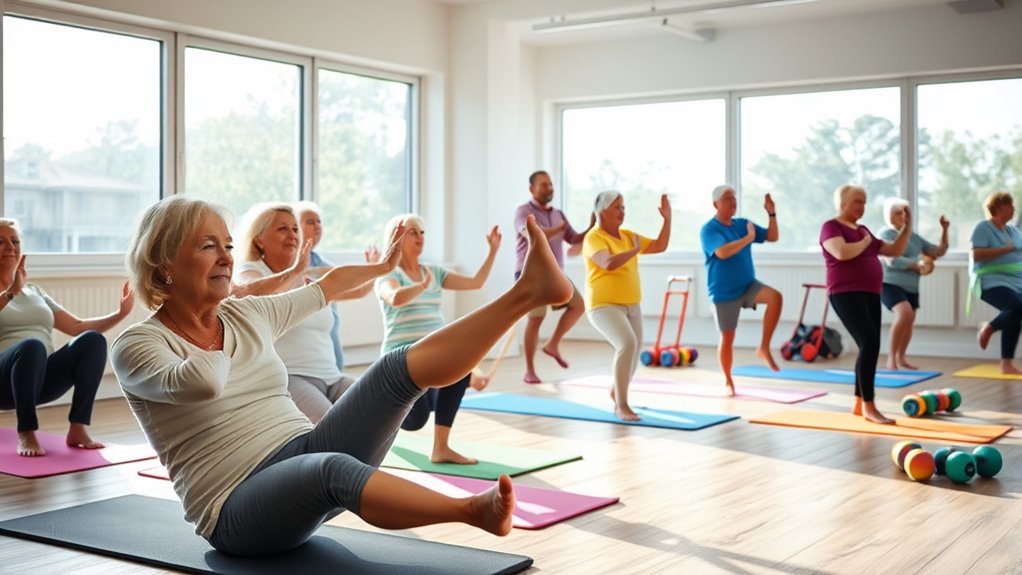
Maintaining strength and balance is essential for seniors, and incorporating leg exercises into your routine can make a significant difference.
Here are the top 10 leg strengthening exercises for seniors: chair squats, calf raises, seated leg lifts, standing knee lifts, leg extensions, side leg raises, toe stands, step-ups, wall sits, and glute bridges.
These low-impact exercises not only help improve balance but also enhance strength and flexibility. By engaging in these activities 2-3 times a week, you can maintain muscle strength vital for everyday activities and reduce the risk of falls.
Safety Precautions for Exercise

Engaging in leg exercises can greatly benefit seniors, but it’s important to prioritize safety while doing so.
Always consult a physician before starting any exercise program, especially if you have chronic conditions or balance issues. Use sturdy furniture or walls for support during your workouts to enhance stability and minimize the risk of falling.
Wear comfortable, non-slip footwear to prevent slipping while you exercise. Start with low-intensity exercises, gradually increasing difficulty as your strength improves to avoid injury.
Remember to stay hydrated throughout your sessions, as proper hydration is essential for overall health and performance.
Incorporating Leg Exercises Into Daily Routine

To make leg exercises a regular part of your daily routine, set specific times each week dedicated to your workouts.
You can also combine these sessions with social activities like walking groups, which can keep you motivated and engaged.
Don’t forget to monitor your progress regularly to see how you’re improving and to adjust your routine as needed.
Set Specific Times
Setting specific times for leg exercises can make a significant difference in your routine. By setting specific days and times each week for your sessions, you’ll not only build strength and endurance but also guarantee consistency in your physical activity.
Aim for at least 2-3 sessions weekly, and don’t hesitate to utilize reminders or alarms on your phone to reinforce this schedule. You can also integrate movement into your daily life; try doing seated leg extensions while watching TV or calf raises while waiting for water to boil.
Adapting your routine based on your preferences and energy levels will help keep things fresh and engaging, making it easier to stick with your leg exercises long-term.
Combine With Social Activities
Incorporating leg exercises into social activities can make your fitness routine more enjoyable and less of a chore. Joining a walking group or participating in a dance class not only enhances your leg strength but also fosters community engagement.
Scheduling regular sessions with friends increases accountability and turns workouts into fun gatherings. Consider outdoor exercise classes in local parks, where you can socialize while enjoying nature.
Hosting a “fitness party” allows you to combine leg-strengthening exercises with socializing in a supportive atmosphere.
Additionally, engaging in community events like charity walks or fitness challenges helps you maintain leg strength while contributing to a cause, strengthening both your body and social connections.
Monitor Progress Regularly
Monitoring your progress regularly not only keeps you motivated but also helps you recognize improvements in strength and mobility. By keeping a journal, you can track your exercise routine and celebrate milestones, enhancing your motivation. Assess your balance and coordination to pinpoint areas needing focus. Gradually increase the intensity or repetitions of your exercises as your strength improves to guarantee continued muscle growth. Visual aids or video demonstrations can assist in maintaining proper form, which is essential for effective progress tracking.
| Date | Exercise Completed | Strength & Mobility Rating |
|---|---|---|
| 2023-10-01 | Squats (10 reps) | 7/10 |
| 2023-10-08 | Lunges (8 reps) | 8/10 |
| 2023-10-15 | Step-ups (10 reps) | 9/10 |
| 2023-10-22 | Squats (12 reps) | 9/10 |
Monitoring Progress and Setting Goals
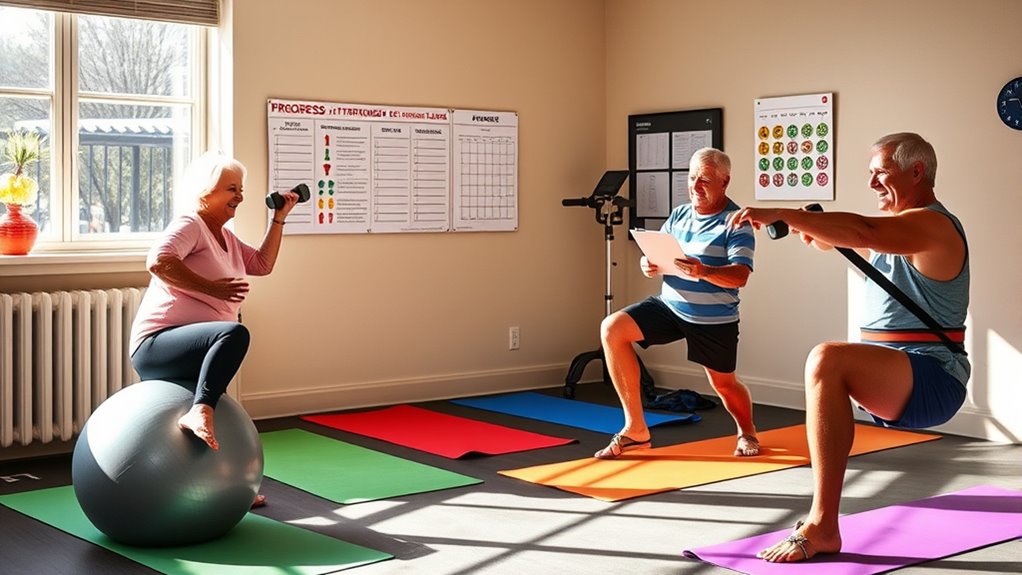
As you begin your leg exercise journey, tracking your progress and establishing clear goals can greatly enhance your experience.
Start by keeping a journal of your exercise routines to monitor improvements in strength and mobility. Set specific goals, like increasing the number of repetitions or sets each week, to encourage consistent progress.
Regularly assess changes in your energy levels, balance, and coordination to evaluate your routine’s effectiveness. Consult with healthcare providers to adjust your program based on your progress and personal goals, ensuring safety.
Celebrate milestones, such as achieving a new personal best or completing a workout without assistance, to boost your motivation and commitment to your fitness journey.
Benefits of Regular Leg Exercise for Seniors

Regular leg exercise offers numerous benefits that can greatly enhance your quality of life as a senior. Engaging in regular leg exercise boosts your mobility and balance, which are essential for preventing falls and maintaining independence.
Strength training for your legs strengthens muscles, considerably reducing the risk of falls and injuries. Additionally, these exercises promote cardiovascular health by improving circulation, crucial for your overall well-being.
They also help maintain or improve your bone density, reducing the risk of osteoporosis and fractures. Beyond physical benefits, regular leg workouts foster greater confidence in mobility, contributing to improved mental well-being.
Community Resources and Support for Seniors
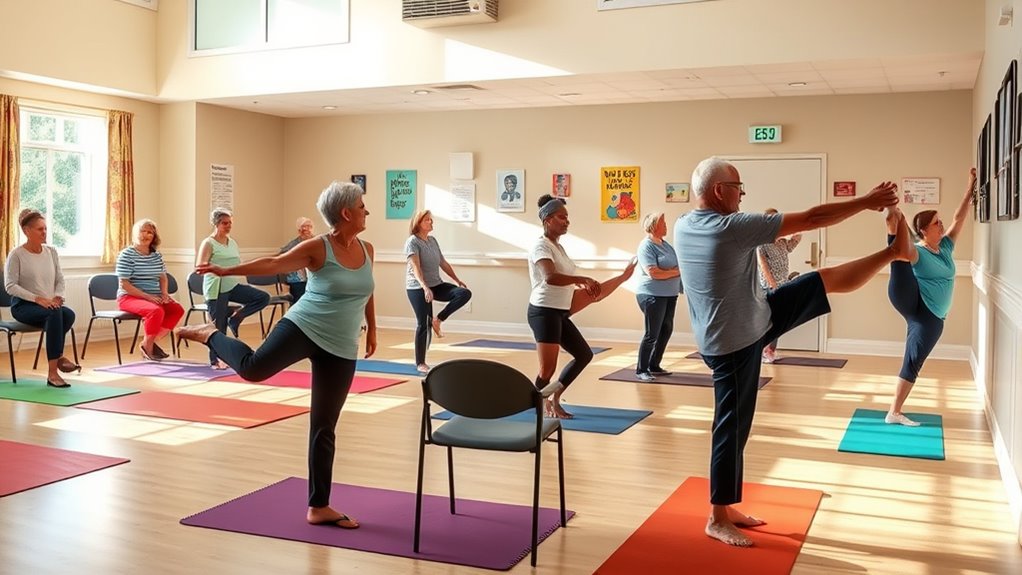
Engaging in leg exercises not only enhances your physical health but also opens the door to a variety of community resources designed to support seniors in staying active. You can explore options like community health programs that provide workshops on fall prevention and strength training. Local senior centers often host exercise classes tailored for seniors, while online platforms offer virtual classes, allowing you to connect with fitness instructors from home.
| Resource Type | Description | Benefits |
|---|---|---|
| Exercise Classes | Local classes designed for seniors | Promotes activity and socializing |
| Physical Therapists | Experts providing personalized exercise plans | Tailored guidance for safety |
| Local Parks | Safe walking paths and outdoor fitness equipment | Encourages regular physical activity |
| Community Programs | Workshops on fall prevention and strength | Free resources for seniors |
Frequently Asked Questions
How to Increase Leg Strength in Seniors?
To increase leg strength, you should incorporate exercises like squats, lunges, and calf raises into your routine at least 2-3 times a week.
Start with 10-12 repetitions and aim to progress to 3 sets. Using support, like a sturdy chair, can help maintain balance.
Include a variety of movements to target different muscles, and track your progress to adjust intensity as needed.
Consistency and gradual increases will lead to better strength and stability over time.
What Is the Best Leg Exerciser for Seniors?
When you’re looking for the best leg exerciser, consider options like resistance bands and seated leg press machines. They provide support and allow you to build strength without the risk of heavy weights.
If you prefer low-impact, a recumbent bike can enhance your cardiovascular fitness while being gentle on your joints.
Adjustable ankle weights and portable leg extenders also offer great ways to increase resistance, helping you gradually improve your leg strength comfortably.
What Is the Best Exercise to Strengthen Weak Legs?
To strengthen weak legs, you should consider exercises that target various muscle groups.
The reverse lunge is great for engaging your glutes, quads, and hamstrings while enhancing stability.
Seated leg extensions focus on your quadriceps, making daily movements easier.
Chair squats build thigh and glute strength, essential for balance.
Finally, calf raises improve lower leg strength, supporting your overall mobility.
Incorporating these exercises can greatly boost your leg strength and coordination.
How Can I Build Leg Muscle After 70?
Have you ever wondered how to keep your legs strong and agile as you age?
To build leg muscle after 70, start by incorporating simple exercises like squats, calf raises, and lunges into your routine 2-3 times a week.
Don’t forget resistance training with light weights or bands.
Focus on balance-enhancing movements, like single-leg stands, to boost stability.
Consistency is key, so make these exercises a regular part of your life for lasting strength.
Conclusion
Incorporating leg exercises into your routine isn’t just a good idea—it’s a game changer! You’ll feel like you’re defying gravity as you build strength and stability. With each squat and lunge, you’re not just working out; you’re revealing the secret to a more active, independent life. So, lace up those sneakers and get moving! You’ve got the power to transform your mobility and embrace a vibrant lifestyle like never before—no cape needed!

